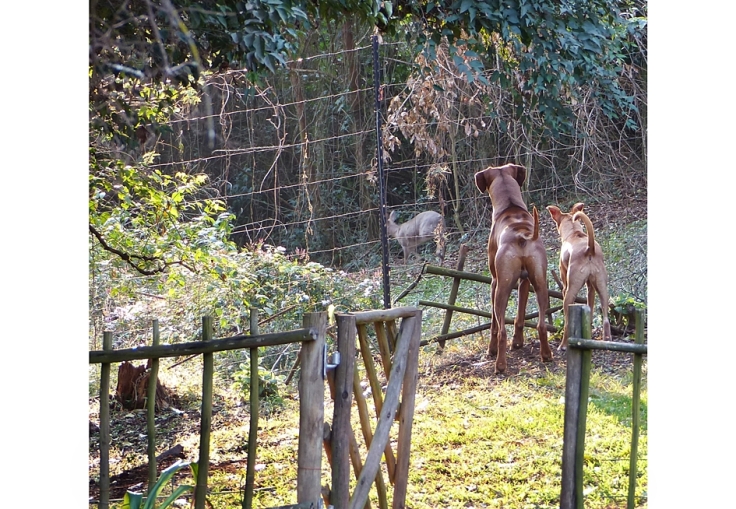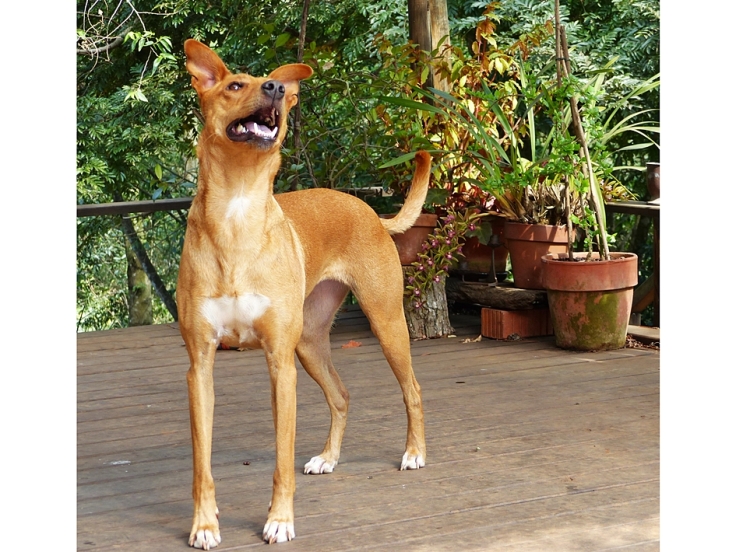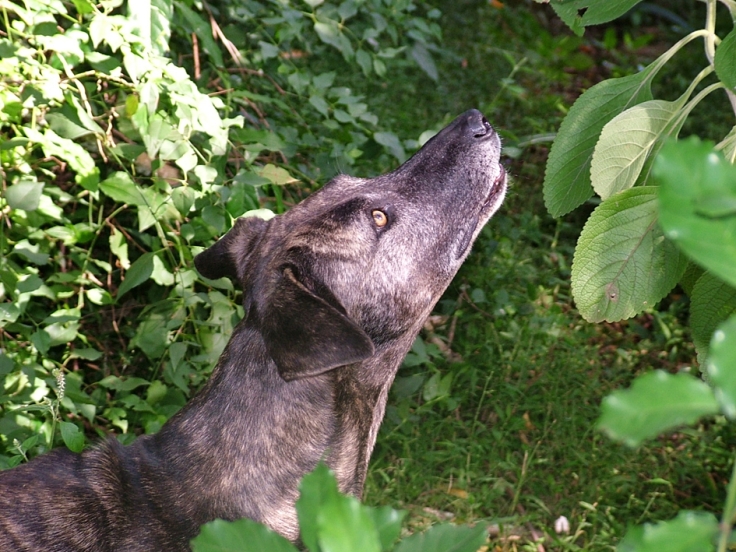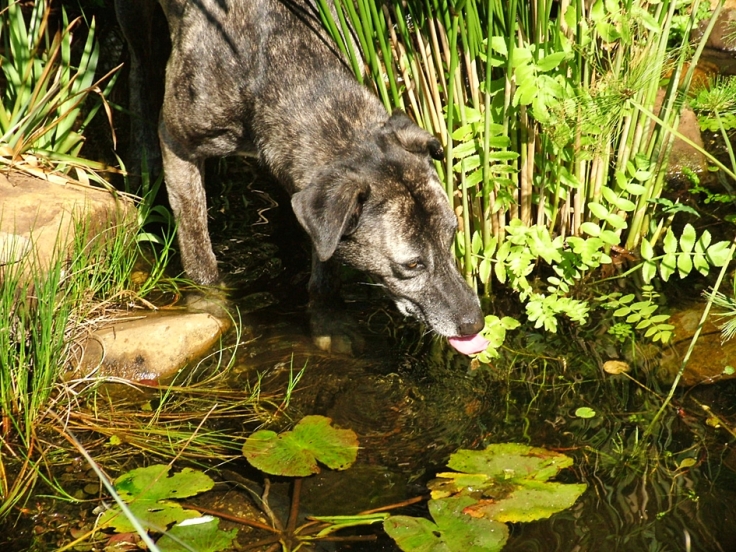Many nature lovers also love domestic animals. Part of letting nature back in can be in the form of sharing our lives with our companion animals. Although there is potential for conflict, pet dogs can coexist with wildlife in a suburban garden. Here are some pointers to good neighbourliness between domestic dogs and wild animals in suburban spaces and gardens.
Good fences make good neighbours
Good fences keep dogs in, but still permit the passage of small animals. Preventing dogs from straying protects them from getting lost, from the dangers of traffic, being picked up by strangers, or (as in our area) being caught in snares set for wildlife. Keeping them in also prevents dogs from chasing, harassing and even killing wildlife and birds. Unfortunately some fences and most walls, block the passage of small animals, trapping them and cutting them off from moving to other areas for feeding, drinking, breeding and safety. That fences should have gaps that enable the movement of small animals is discussed in an earlier post on the Slender Mongoose. One option is to use wire fencing with fairly large mesh, such as bonox, and another is to have sections of the boundary enclosed with dense and even thorny hedging. The intention is to provide a barrier to keep dogs in, but enable the passage of small animals such as toads and mongooses.

Our dogs watching through the fence a wild grey duiker that survives in the plantation, which borders the properties on our street.
Keeping dogs in at night
Not all dogs are keen on hunting, but for those that are, keeping them inside at night prevents them from harassing nocturnal animals.

Toads are active at night and breeding-time choruses are one of the sounds of summer. Best to keep toads and other nocturnal animals safe from pet dogs
Teaching good manners
Most dogs can be taught not to chase or bark at animals and birds, including ground-foraging birds such as hadedas. A friend’s dogs chase hadedas at their own home, but when they visit us, after an early reprimand, they now ignore “our” hadedas – even when the birds are in close proximity – perhaps also modelling their behaviour on what our dogs do.
It is true that some dogs with a stronger prey drive are harder to teach than others. We had one dog, named Ben, who needed a lot of monitoring as he could not restrain himself from chasing even small birds. Although, strangely, he didn’t mind skinks and geckoes, and one day when lying on our garden deck, he didn’t twitch a muscle as he allowed a fairly large skink to walk over the length of his body!
We have two dogs currently, and one does want to hunt geckoes despite us discouraging her. She is very alert to the presence of snakes and lets us know by a few focussed barks of any visiting snakes, but she keeps a respectful distance. She is fine with the hadedas, who carry on foraging on the lawn, even when the dogs walk by. I love to see this live and let live approach!

Our rescue dog, Amy, keeping a wary eye on a Green Snake in the grape vine that shades our garden deck
We have taught our dogs not to bark at monkeys, but, regrettably, they still want to chase them even though they do it quietly! Fortunately, the monkeys are alert and stick to the trees when the dogs are out and about. When we are at home and the monkeys are around, we shut the dogs inside. I am aware that many people dislike monkeys, but monkeys have little habitat left and so are forced to share spaces with humans, and in these shared spaces they are persecuted, including being deliberately killed or injured by guns and catapults, as well as being accidently killed or injured by traffic. I like that our garden can provide some respite. We plant indigenous trees for them to forage in, and they can drink from the bird baths, and for us, watching them interacting peacefully when they are not harassed is really interesting. They too interact harmoniously with the hadedas in the garden.

Our Africanis dog, Ben, in his younger days, silently watching monkeys in the trees
Dogs and plants
As our garden is “informal” and definitely not manicured, we do not mind the odd bit of digging. Every summer, our dog Ben used to dig himself a cool place to lie under a bush. We let him do that and we did not interfere with Ben’s den.
On occasion, the dogs dig in the lawn, sensing the presence of moles. If the digging becomes too persistent, the solution is to bury some dog poop where they are digging and that seems to put them off. (On the subject of moles, if they make molehills in the lawn, we simply rake the molehills flat and say thank you to the moles for providing some top dressing.)
When it comes to dogs and edible plants – obviously it is not good when they dig up one’s veggies, and also I am not comfortable with dog poop and pee on the edible plants. In our garden, our veggie patch is fenced (including the “roof”) – it keeps out the monkeys and the dogs, and so the veggies are kept intact and hygienic with no need for conflict.
Dogs like to self-medicate by eating grass, and it is interesting to see that they prefer indigenous grasses to the lawn varieties.

A young Amy, eating grass in our mini grassland
Dogs and ponds
We made our garden pond ourselves, and rather than worry about dog claws puncturing plastic linings, we lined our pond with concrete and sealed it with bitumen. After some years the bitumen deteriorated, and the pond is now sealed with cemcrete. Should the dogs go into the pond for a drink or a dip, we have no worries about damage to the pond.

Ben, now dearly departed, drinking from the pond
Peace and quiet
As we like our wildlife garden to be a peaceful and quiet spot, we have trained our dogs not to bark at pedestrians passing by. After all, everyone is entitled to walk in the street without provoking a flurry of barking. When we sit out on our back deck for some time out, the dogs stay alongside us watching and listening, and seemingly enjoying their spot of companionable R&R too. For a companion piece on cats and the wildlife garden see here

Watching the world go by

Posted by Carol








March 14, 2017 at 11:03 pm
Would that all dogs were trained to respect other forms of life as yours clearly are. Problems begin with owners that take the attitude that their dog is a superior life form that has every right to chase or disturb anything it may encounter. It’s definitely owners that need training!
LikeLike
February 6, 2017 at 8:36 am
My mum’s dogs came over to be dog sat, back when we lived apart. At home they had been ratters but we had pet rats. They barked but stopped when we told them to, the poor male kept whining & pointing at the huge cage. Hubby said he was trying to tell us rats had gotten into our ornament. So I went and cuddled a couple of rats and our dogs nuzzled them. Within an hour mum’s dogs were nosing the rats through the bars while the rats (who loved dogs & cats) fed them and patted them. It was so cute.
LikeLiked by 1 person
February 6, 2017 at 9:54 am
Great story, great outcome, and definitely cute! Your hubby’s translation of the dog’s thought process and what he was trying to tell you is hilarious. Yikes! So much dissonance in the system! Love the way it got sorted – the power of show and tell 🙂
LikeLiked by 1 person
February 6, 2017 at 11:40 am
Thanks 🙂
LikeLike
February 3, 2017 at 8:45 pm
Fantastic toad photo!
LikeLiked by 1 person
February 3, 2017 at 9:13 pm
Thanks Margaret. I wasn’t sure if he would mind being in the limelight, but he kept on singing! Torch singing 🙂
LikeLiked by 1 person
January 30, 2017 at 6:27 pm
Currently I have one “civilized” dog and another who goes ballistic when she sees squirrels. We have a split-rail fence with wire that easily allows passage for wildlife, but training is the only thing that has kept our young dog from jumping it!
LikeLiked by 1 person
January 31, 2017 at 6:12 am
Definitely each dog is different but most respond to consistent routines in time. I wonder what our dogs would think of squirrels as they do not occur here.
LikeLiked by 1 person
January 30, 2017 at 1:52 pm
I have greatly enjoyed reading this – and love your photographs! I am glad you like your hadedas and I feel exactly the same about molehills.
LikeLike
January 31, 2017 at 6:06 am
Thanks so much Anne. Great that you feel the same about molehills and also appreciate the presence of hadedas.
LikeLiked by 1 person